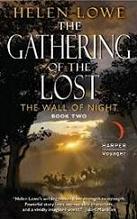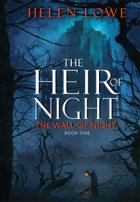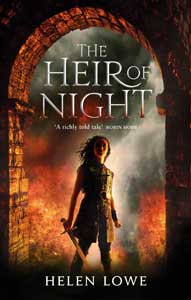Inside The Writing Life: A Little About The Writing Itself

Inside the Writing Life…
On April 20, I posted a few Reflections On Writing the Long Form & WALL#4 Progress, as part of which I talked about posting a little more from inside the writing life.
I was reflecting further on how to kick off this topic when The Wall Of Night readers took the matter out of my hands with a few comments on the blog post, and a few more on Twitter. All of which, just by the way, confirmed my view expressed in the post: that WALL readers (and I’m quite sure Thornspell readers, too) are characterized by “general all-round virtue.” 🙂

USA
The comments reflected readers’ experience of the books, for example that WALL #1 – #3 are frequently reread, providing both the contentment of familiarity while still remaining “fresh and suspenseful” and conveying both a “plot and character…tingle.” (Thanks Jacqui and Steve respectively.) While Ellen commented that:
“Daughter of Blood was phenomenal; I cried and cried at the end, and that’s a good thing, actually. It means you did your job and did it well and really moved me.”

UK/AU/NZ
My initial response was just “wow.” (In an entirely good way, I hasten to add.) But I also wanted to reply to these comments from inside the writing life, not just because as a writer I love to hear that readers have enjoyed my books, but also because these responses connect directly to the “how” and “why” of my writing process.
Firstly, I’m a re-reader myself, and have many books in my life that are old and trusted friends that I often return to and enjoy spending time with again. So I love that my books slip into some readers’ lives in the same way. When I write, I don’t consciously think, I want people to re-read these books. But I do want to write great stories, where people really care about the characters and what happens to them, and write in a way that has both nuance and depth so that a returning reader may find some new insight or angle, as well as re-experiencing the tried and true of their first reading.

5% inspiration.
Sometimes that kind of writing just flows from the pen, and when that happens it’s always awesome and often quite magical, too. You may recall, though, that I mentioned the 5% inspiration: 95% perspiration formula in my 20 April post, which of course reveals that the magical flow is rarer than you might think, and certainly more so than I would like! And yet… (I’ll come back to the “and yet.”)

Tricksy…
So most of the time, the work-in-progress and the author are firmly in the land of 95% perspiration. Sometimes that occurs because the story is like a giant jigsaw puzzle where there are not only a LOT of pieces but those pieces can be quite “tricksy” (as Gollum would have it when speaking of “hobbitses.”) In the case of books and long-from writing, the tricksiness may lie in pieces appearing to fit together, but gradually the poor benighted author realises that they don’t, quite. At this juncture the only thing to be done is to backtrack until you find the piece that started author and story down the “not-quite-fitting” path. Or sometimes wildly not fitting, but you only see it when you look back…

No kicking the cat!
This process requires both a firm understanding of the big picture and simultaneously a lot of attention to detail—not to mention patience! And maybe a modicum of bloody-mindedness, to work it all out. Not infrequently, too, (in my case—I cannot speak for other authors!) there may be accompanying bad language. Furthermore, items breakable and unbreakable may be thrown, metaphorically if not literally, and cats, if they were not adept at making themselves scarce, might be in danger of being kicked…

It’s always about the characters
This tricksiness mostly applies to plots, with all the attendant considerations of subtexts, pacing, and the invisible but all-important story structure. BUT it may also apply to character development. Mostly, when all the myriad pieces that make up a character appear to fit but then you realise they really don’t, it’s for reasons that may be grouped under the general headings of consistency and continuity, which are sometimes almost the same thing and sometimes not.
Yet for whatever reason, what it boils down to is that characters must remain true to themselves. Because if they don’t, if the author thinks maybe she’ll just take a character shortcut to make the plot work out, then (imho) nothing in the unfolding story will ring true.

Sometimes it takes two typewriters — or PCs. 🙂
And it’s the ringing true, I believe, that leads us to buy into characters as readers, and laugh and cry, and dare and win, or strive and lose with them. So I’ll keep working away on the characters and their stories until I feel they’re pitch-perfect: that they’ll resonate sufficiently with readers for those like Ellen to cry over their fates. That’s the “tingle” and it’s also doing my job, and sometimes (as alluded to when reflecting on the long form) it’s also blood, sweat and tears territory. Or as Ernest Hemingway so succinctly put it: “There’s nothing to writing. All you do is sit at the typewriter and bleed.”

Optimus maximus…
Do you remember that I said, “And yet…” up above? The reason I said it is because reaching a good result as a result of the sheer hard work and grind and perseverance of the 95% perspiration can be as rewarding as the 5% that springs into being fully formed (like Athena from the brain of Zeus), only in a different way. Somewhat like the stump in Shane, if you’ve ever read the book. And it’s always really affirming to receive feedback that suggests the work and effort has proven worthwhile for readers. So a big thank you to all of you, both on the recent post but also at other times, who have taken the time to let me know that.
“Think of this – that the writer wrote alone, and the reader read alone, and they were alone with each other.” — A.S. Byatt, Possession.







